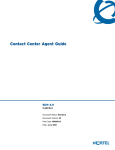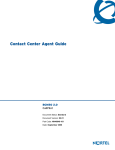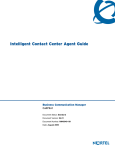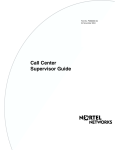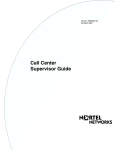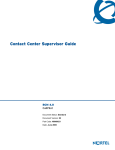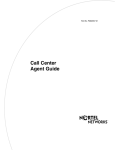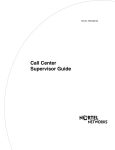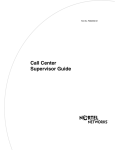Download Avaya Call Center User's Manual
Transcript
Part No. N0015708 02 24 November 2004 Call Center Agent Guide 2 Call Center Agent Guide Copyright © 2004 Nortel Networks All rights reserved. 2004. The information in this document is subject to change without notice. The statements, configurations, technical data, and recommendations in this document are believed to be accurate and reliable, but are presented without express or implied warranty. Users must take full responsibility for their applications of any products specified in this document. The information in this document is proprietary to Nortel Networks NA Inc. Trademarks NORTEL NETWORKS is a trademark of Nortel Networks. Microsoft, MS, MS-DOS, Windows, and Windows NT are registered trademarks of Microsoft Corporation. All other trademarks and registered trademarks are the property of their respective owners. N0015708 02 3 Call Center Agent Guide This guide explains how agents use Call Center. The topics covered in this guide are: About Call Center page 3 Logging on to Call Center page 4 Logging on to Multimedia Call Center page 5 What you should log on to page 5 Logging off Call Center page 6 Changing your agent password page 7 Using Feature Codes: Log On Supervisor Help Activity Codes Display Waiting Calls Not Ready page 8 page 9 page 10 page 11 page 12 page 8 - 12 Programming a memory button page 13 Other Call Center features page 14 Important considerations about using features page 16 Skillset mailboxes page 17 About Call Center Call Center is an application that handles incoming calls as efficiently and economically as possible. Call Center answers calls, then routes the calls to agents in a skillset that most closely meets the needs of the caller. If there are no agents available, the calls are placed in a skillset to wait for an appropriate agent. Waiting callers receive periodic announcements and informative messages. Other guides For information about Refer to using your telephone your telephone user card using CallPilot • the CallPilot Reference Guide • the CallPilot Quick Reference Card for your telephone interface Call Center supervisors the Call Center Supervisor Guide Multimedia Call Center Multimedia Call Center online Help Call Center Agent Guide 4 Call Center Agent Guide Logging on to Call Center Log on to Call Center so that calls can be routed to you. You cannot log on if the maximum number of agents is logged on, if you are logged on to another telephone, or if someone else is logged on to your telephone. You can log on only to skillsets that you are assigned to. Logging on from a two line display telephone 1 Press ≤·‚›. 2 Enter your Agent ID and press OK or £. Your Call Center Administrator can tell you your Agent ID. 3 Enter your password and press OK or£. The first time you log on, or when you log on after your password has been reset, enter the default password, 0000. If you enter the default password, you must create a new password. 4 Press IN to log on to one or all skillsets. If IN does not appear, you are already logged on to all the skillsets, or there are no skillsets available. 5 Press CHNG until the skillset that you want to log on to appears on the display. If you log on to all of the skillsets, you are logged on to all the skillsets that you are assigned to. If there is only one skillset available to log on to, you are automatically logged on to that skillset. 6 Press OK. You are logged on to the skillset number displayed, or all of the skillsets if ALL is displayed. 7 If you are a Multimedia Call Center agent, the prompt Also log in to PC appears. 8 Press ®. Logging on from a one line display telephone When you log on from a one line display telephone you also log on to all skillsets you are assigned to. 1 Press ≤·‚›. 2 Enter your Agent ID and press £. Your Call Center Administrator can tell you your Agent ID. 3 Enter your password and press £. The first time you log on, or when you log on after your password has been reset, enter the default password, 0000. If you enter the default password, you must create a new password. 4 Your agent name and Logged into all appears on the display to show that you are logged on to all of the skillsets you are assigned to. If you belong to only one skillset, Logged into XX appears, where XX is the number of the skillset you belong to. If Logged out all appears, repeat steps 1 through 3 to log on. 5 If you are a Multimedia Call Center agent, the prompt Also log in to PC appears. Note: If you use a Companion 3060 telephone, there are no indicators, and the display does not show that you are logged on or the skillsets that you are logged on to. N0015708 02 Call Center Agent Guide 5 Logging on to Multimedia Call Center If you are taking only voice calls Log on to your telephone the same way you do as a Call Center agent, as described in “Logging on to Call Center” on page 4. If you are taking only browser calls On your computer, click the Start button, point to Programs, point to Nortel Networks, point to Multimedia Call Center and click Agent Notification. The Agent Notification page appears. Log on to Multimedia Call Center. For information about using Multimedia Call Center, click Help. If you are taking voice and browser calls Log on to your telephone the same way you do as a Call Center agent, as described in “Logging on to Call Center” on page 4 and then log on to Multimedia Call Center on your computer. What you should log on to Ask your Call Center Supervisor whether you can receive only voice calls, only Multimedia Call Center calls, or both voice and Multimedia Call Center calls. This table shows what you should log on to, depending on what type of calls you can receive. Type of calls you can receive Voice Multimedia Call Center Both Are you logged onto a telephone? Are you logged Can you have onto Multimedia voice calls? Call Center? Can you have phone and browser Multimedia Call Center calls? Can you have browser only Multimedia Call Center calls? No Not permitted No - - YES Not permitted YES - - No No - No No No YES - No YES YES No - No No YES YES - YES YES No No No No No No YES No No No YES No No No No YES YES YES YES YES Call Center Agent Guide 6 Call Center Agent Guide Logging off Call Center When you are finished for the day or will be away from your telephone for an extended period, log off to stop calls from being routed to your telephone. Logging off from a two line display telephone 1 Press ≤·‚›. 2 Enter your Agent ID and press OK or £. 3 Enter your password and press OK or £. 4 Press OUT. If OUT does not appear, you are not logged on to any skillsets. 5 Press CHNG until the skillset you want to log off from appears on the display. If you are logged on to only one skillset, that skillset is automatically selected. 6 Press OK. 7 You are logged off from the skillset number displayed, or from all skillsets if ALL is displayed. 8 Press ®. Logging off from one line display telephone When you log off from a one line display telephone you are also automatically logged off from all the skillsets you are logged on to. 1 Press ≤·‚›. 2 Enter your Agent ID number and press £. 3 Enter your password and press £. If you are logged on to multiple skillsets, Logged out all appears on the display to show you are logged off from all skillsets or if you are logged onto one skillset, Logged out xx appears, where xx is the skillset you were logged on to. 4 Press ®. Note: If you use a Companion 3060 telephone, there are no indicators, and the display does not show that you are logged on or the skillsets that you are logged on to. N0015708 02 Call Center Agent Guide 7 Changing your agent password Your Agent ID and password give you access to the skillsets you are assigned to. Keep your password confidential. Change your password on a regular basis, approximately every 30 days. Changing your password from a two line display telephone 1 Press ≤·‚›. 2 Enter your Agent ID and press OK or £. Your Call Center Administrator can tell you your Agent ID. 3 Enter your password and press OK or £. 4 Press Admin. 5 Enter a new password that is from four to eight digits long and press OK or £. Your password cannot start with a zero. 6 Re-enter your new password and press OK or £. Password changed is briefly displayed. 7 Press ®. Changing your password from a one line display telephone 1 Press ≤·‚›. 2 Enter your Agent ID and press £. Your Call Center Administrator can tell you your Agent ID. 3 Enter your password and press £. Your log on status changes from Logged on to Logged off or Logged off to Logged on. 4 Press › within the next five seconds. 5 Enter your new password and press £. Your password cannot start with a zero. 6 Re-enter your new password and press £. Password changed is briefly displayed. 7 Your original log on status appears. Call Center Agent Guide 8 Call Center Agent Guide Using Feature Codes You use Feature Codes to access Call Center features. The default Feature Codes are shown below. Your Call Center Administrator can program Custom Feature Codes that you use instead. If you use Custom Feature Codes, you can record them in the spaces below. Feature Default Feature Code Custom Feature Code Open mailbox ≤·°⁄ ≤· ___ ___ Log on/Log off ≤·‚›* ≤· ___ ___ Supervisor Help (may not available on your system) ≤·‚fl* ≤· ___ ___ Activity Codes ≤·‚‡* ≤· ___ ___ Not Ready ≤·‚°* ≤· ___ ___ Display Waiting Calls ≤·‚·* ≤· ___ ___ *You can program these Call Center Feature Codes to memory buttons. For how to program a Feature Code to a memory button refer to “Programming a memory button” on page 13. Note: While you are using a feature, if you press the Feature ≤ button your present feature session ends. Do not press ≤ unless you want to end your current feature session. Log on ≤·‚› Use ≤·‚› to log on to Call Center and the skillsets you are assigned to. You can program a memory button with the Log on Feature Code. If the memory button you choose has an indicator, the indicator shows your log on status. • If the indicator is off, you are not logged on. • If the indicator is on, you are logged on. For information about how to program a memory button, refer to “Programming a memory button” on page 13. N0015708 02 Call Center Agent Guide 9 Supervisor Help ≤·‚fl With Supervisor Help an you can request help from a supervisor while you are on a call by pressing a programmed feature button. You can send an urgent request for help without interrupting the call, and without the caller being aware of your help request. Note: Whether you can use Supervisor Help depends on the system your Call Center uses. Ask your supervisor whether you can use Supervisor Help. Supervisor Help is for situations where you are on a call and urgently require the help of a supervisor without alerting the caller that a supervisor is being called in. It is not intended for routine consultations or when you are not on a Call Center call. You must be logged on to Call Center and on a Call Center call to use Supervisor Help. To use Supervisor Help you must have a memory button programmed with the Supervisor Help Feature Code (F906). The programmed key must have an LCD indicator. The memory button can have a distinct bright color so it can easily be distinguished from the other buttons. For how to program a memory button refer to “Programming a memory button” on page 13. Call Center Agent Guide 10 Call Center Agent Guide Activity Codes ≤·‚‡ You use Activity Codes to allocate calls to certain activities. You can press ≤·‚‡ to start an Activity Code session anytime during or after the call until your Break Time ends. Enter Activity Codes early in your Break Time to ensure that Call Center records them. If your Activity Code sessions are prompted, and you have not entered an Activity Code by the end of the call, your telephone display automatically prompts you to enter Activity Codes. We recommend you program a memory button with ≤·‚‡. For how to program a memory button, see “Programming a memory button” on page 13. If your Activity Code sessions are prompted, and you park and page a call, after you park the call an Activity Code session will not automatically appear on your telephone. If you want to enter an Activity Code for the call, you can do it during your Break Time by pressing ≤·‚‡. The ≤·‚‡ session remains on your telset for 2 minutes, unless you enter an Activity Code or release the ≤·‚‡ session How to have an Activity Code session 1 During or after a call, anytime until your Break Time ends, press ≤·‚‡ to start a session. If you are prompted to enter Activity Codes, the ≤·‚‡ session starts automatically. Activity Id: RETRY 2 Enter an Activity Code number and press OK. Sales support RETRY OK 3 The Activity Code name is displayed, in this example Sales support. Press OK to confirm this is the correct Activity Code or press RETRY to return to the display on step 2. Another actv? YES NO 4 You can press YES to enter another Activity Code or press NO or RLS to end the ≤·‚‡ session. OK You can enter a maximum of 5 Activity Code during a F907 session. You can have multiple F907 sessions during a call, and one session after the call ends. Note: Ask your Call Center supervisor for the list of Activity Codes. N0015708 02 Call Center Agent Guide 11 Display Waiting Calls ≤·‚· Use Display Waiting Calls to view information about skillsets and the calls waiting in skillsets. The table below describes the information in each display. Display Description Skill 1: Enabled shows the skillset number and the status of the skillset. The status can be Enabled, Disabled or Uninit (uninitialized). 1: 6 agents shows the skillset number and how many agents are currently logged on to the skillset 1: 10 calls shows the skillset number and the number of calls waiting in the skillset 1: wait 9:45 shows the skillset number and the time of the call waiting longest in the skillset. To Display Waiting Calls 1 Press ≤·‚·. The skillset display for skillset 1 appears. On a one line display telephone press On a two line display telephone press ⁄ ⁄ or GOTO ¤ ‹ or fl ¤ or SKILL ‹ or fl or NEXT › £ • ® › or PREV £ • ® To enter the number of the skillset you want to monitor monitor the next enabled skillset go to the next skillset go to the previous menu go to the next menu cancel the session exit Using Display Waiting Calls with a memory button Program a memory button with ≤·‚· to view the status of all skillsets, including the skillsets that you are logged on to. If the memory button you choose has an indicator, the indicator shows information for the calls for the skillset that you are logged on to. • If the indicator is off, all of the calls are within the acceptable wait time. • If the indicator is flashing slowly, at least one call has exceeded the first alert time. • If the indicator is flashing quickly, at least one call in the skillset has exceeded the second alert time. The Call Center Administrator sets what the alert times are. For information about how to program a memory button, refer to “Programming a memory button” on page 13. Call Center Agent Guide 12 Call Center Agent Guide Not Ready ≤·‚° If you use Not Ready, you do not receive calls. Your Call Center Administrator can also program a Break Time, which makes Call Center automatically wait a short time before it routes the next call to you. You can use the Break Time to complete any paperwork required by the last call. If you need some extra time, use Not Ready to prevent Call Center from routing another call to you. Do not use the Do Not Disturb feature. You can use Not Ready while a call is ringing on your telephone. The call that is ringing on your telephone goes back to the skillset. We recommend that you program a memory button with an indicator instead of pressing ≤·‚°. For how to program a memory button, refer to “Programming a memory button” on page 13. Note: While you use Not Ready, you still receive non-Call Center, intercom and transferred calls. Using Not Ready 1 Press ≤·‚°. Make Not Ready appears on the display. If you press ≤·‚° and Break canceled appears on the display, you canceled the Break Time that the Call Center Administrator programmed for you. You must press ≤·‚° again to activate the Not Ready feature. If you press ≤·‚° and Agent active appears, the Not Ready feature was on and you canceled it. Press ≤·‚° again to activate Not Ready. 2 Cancel the Not Ready feature by pressing ≤·‚° when you are ready to take calls again. If Not ready appears, press ≤·‚° again. Not Ready is automatically enabled if you do not answer your telephone, if Not Ready is configured in Call Center. Programming Not Ready to a memory button You can have convenient, one button access to Not Ready if you program a memory button with the Not Ready Feature Code. If the memory button you choose has an indicator, the indicator shows your busy status. • If the indicator is off, Not Ready is off. • If the indicator is on, Not Ready is on. • If the indicator is flashing, the Break Time feature is on. For how to program a memory button, refer to “Programming a memory button” on page 13. N0015708 02 Call Center Agent Guide 13 Programming a memory button You can program memory buttons for one-touch access to Call Center features. You can program memory buttons for: • Log on ≤·‚› • Supervisor Help ≤·‚fl (If it is available for your system) • Not Ready ≤·‚° • Activity Codes ≤·‚‡ • Display Waiting Calls ≤·‚· You cannot assign features to Line, Intercom, Answer or Handsfree/Mute buttons. Programming a feature to a memory button 1 Press ≤•‹. 2 Press the memory button that you want to program. 3 Press ≤ and enter the feature code. 4 Use the paper labels that come with your telephone to identify the programmed button. To use the Feature Code, press the labeled button. Memory button indicators Memory button indicators are triangular icons (ˆ) that appear beside some memory buttons. If you program Call Center features on memory buttons with indicators, the indicators show additional information about the feature. Call Center Agent Guide 14 Call Center Agent Guide Other Call Center features Using Automatic Answer If you have Automatic Answer enabled, you can use handsfree to answer calls. An audible tone tells you that you have an incoming call. Ask your Call Center Administrator if you have Automatic Answer enabled. Handsfree calls are convenient and time saving because you do not have to use the handset or press buttons on your telephone. If you use Automatic Answer, be sure to activate the Not Ready feature before you leave your desk so that callers are not routed to your telephone when you are away. How Automatic Answer works depends on what type of telephones your call center uses: • i2002 and i2004 IP telephones: If you connect the headset before you initialize the phone, calls are heard over the speaker. If you initialize the IP telephone before you plug in the headset, calls go to the headset as long as you have initialized the headset by pressing the headset button and then the release button. Calls always ring at the IP telephone. Every time you reconnect the headset you must initialize the headset. Meridian and Norstar telephones: If you use a headset, calls ring at the telephone and the headset, but calls go to the headset. Business Series Terminals: If you connect the headset before you connect the telephone cable to the phone jack, calls goes to the handsfree speaker. If you plug in the telephone before you connect the headset, calls go to the headset as long as you have initialized the headset by pressing the headset button and then the release button. Calls always ring at the set. Every time you reconnect the headset you must initialize the headset. Calls always ring at the set. T7316e: This type of telephone is safe to use for Automatic Answer. • • • Transferring calls If you have a caller who needs to talk to another person or is routed to the wrong skillset, you can transfer the call. Do not use the Call Park feature. Transferring a call 1 Press ≤‡‚, or TRANSFER on a two line display telephone. 2 Enter the extension of the person or skillset. 3 Press ®, or JOIN on a two line display telephone. N0015708 02 Call Center Agent Guide 15 Viewing call information Your telephone display shows information about your current call. Information about Multimedia Call Center calls is not displayed. While the call is ringing, the display shows the skillset the call came from. If your call center is configured to show the Caller ID first, the Caller ID is shown briefly followed by the Skillset name. When you answer a call, the display shows the Caller ID of the caller. While you are on a call, you can press the INFO softkey to display: • • • the telephone number the caller is calling from the caller name the line the call came in on Silent Monitor Call Center Supervisors have the ability to silently monitor your calls, including personal calls. If you make a call that you do not want to be monitored, first log off as an agent, then log on again when you complete your call. Call Center Agent Guide 16 Call Center Agent Guide Important considerations about using features Activity Codes Agents who answer a call on an Answer DN telephone or use Call Pickup on a call that is ringing at another agent’s set cannot enter Activity Codes. Call Transfer You can use Transfer to transfer a call to another agent, another person such as a subject matter expert, or send the call back to a skillset. • • To send the call to a specific agent or another person, enter the Transfer Feature Code (≤‡‚) and enter the extension number. For more information on transferring a call, refer to “Transferring calls” on page 14. To send the call to a skillset, enter the Transfer Feature Code (≤‡‚) and enter the CDN of a skillset. If you want to transfer a call to a mailbox, use ≤·°fl. Multimedia Call Center agents do not receive Call Center voice calls, but other Call Center agents can transfer voice calls to Multimedia Call Center agents. Call Forward Do not use Call Forward. If you use Call Forward you are automatically logged out or made busy, depending on your agent settings. You can use Call Forward to the voicemail DN. Call Forward No Answer (CFNA) If you forward a call by CFNA to another agent and the call is answered by that agent, because of your CFNA setting you are made Not Ready or logged out instead of staying idle. Answer DN The only way you should use Answer DN is if you program your portable set to be the Answer DN for your main telephone. If you use your Answer DN telephone to answer a call that is transferred to you, Call Center does not recognize you as being busy, and still sends calls to your main set. Agents who log on from a regular telephone and answer Call Center calls using an answer DN key from a portable telephone cannot use Supervisor Help (F906). Do Not Disturb Instead of using Do Not Disturb, use the Not Ready Feature Code (≤·‚°). If you use Do Not Disturb, you are automatically logged out or made Not Ready. Follow-me browsing (Multimedia Call Center Agents only) Follow-me browsing does not work with embedded Flash animations. If you click a Flash button, the image that you see is not displayed to the caller. If the page you are sending to the caller contains Flash animations, you must explain to the caller how to display the page by, for example, clicking the Next button, or telling them what item to click on the page to display the next page. N0015708 02 Call Center Agent Guide 17 Skillset mailboxes Each skillset has a skillset mailbox assigned to it. Skillset mailboxes store messages left by callers. Check these mailboxes on a regular basis to ensure that customer messages are responded to promptly. Checking skillset mailboxes for messages Frequently check skillset mailboxes for messages. Only one agent at a time can retrieve messages from each skillset mailbox. If different agents access the messages in the skillset mailbox throughout the day, each agent should: • • • • listen to the message write down what the message says erase the message return the caller’s telephone call If the caller is not available, the agent can try again later or give the message to another agent. If only one agent retrieves the messages at your call center, they do not need to transcribe and delete each message before callback. This agent knows the status of the old messages. Playing messages in a skillset mailbox 1 Press ≤·°⁄. Follow the voice prompts or the display button options on your telephone to open the skillset mailbox. 2 Press PLAY or ¤ to listen to your messages. For other options, refer to the user card for your telephone or the CallPilot Reference Guide. 3 Press ® to end the session. Call Center Agent Guide 18 Call Center Agent Guide N0015708 02


















